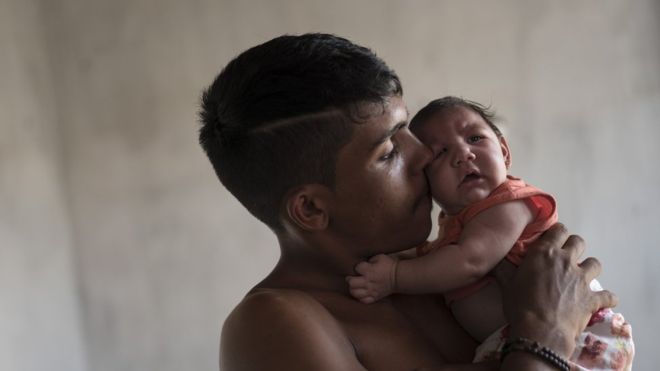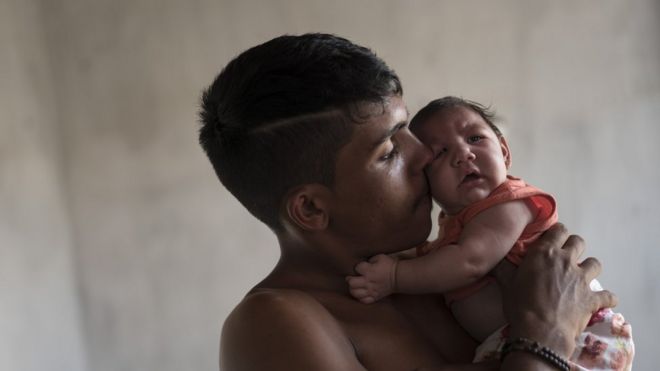
The infection is suspected of leading to thousands of babies being born with underdeveloped brains.
Some areas have declared a state of emergency, doctors have described it as “a pandemic in progress” and some are even advising women in affected countries to delay getting pregnant.
But there is much we do not know in this emerging infection.

What are the symptoms?
Deaths are rare and only one-in-five people infected is thought to develop symptoms.
These include:
- mild fever
- conjunctivitis (red, sore eyes)
- headache
- joint pain
- a rash
A rare nervous system disorder, Guillain-Barre syndrome, that can cause temporary paralysis has been linked to the infection.
There is no vaccine or drug treatment so patients are advised to rest and drink plenty of fluids.
But the biggest concern is the impact it could have on babies developing in the womb and the surge in microcephaly.

What is microcephaly?

It is when a baby is born with an abnormally small head, as their brain has not developed properly.
The severity varies, but it can be deadly if the brain is so underdeveloped that it cannot regulate the functions vital to life.
Children that do survive face intellectual disability and development delays.
It can be caused by infections such as rubella, substance abuse during pregnancy or genetic abnormalities.
Brazil had fewer than 150 cases of microcephaly in the whole of 2014.
But more than 4,700 cases have been reported since 22 October 2015, with 404 confirmed and 3,670 still being investigated.
The link with Zika has not been confirmed, but the WHO says it is “strongly suspected”.
Some babies who died had the virus in their brain and it has been detected in placenta and amniotic fluid too.
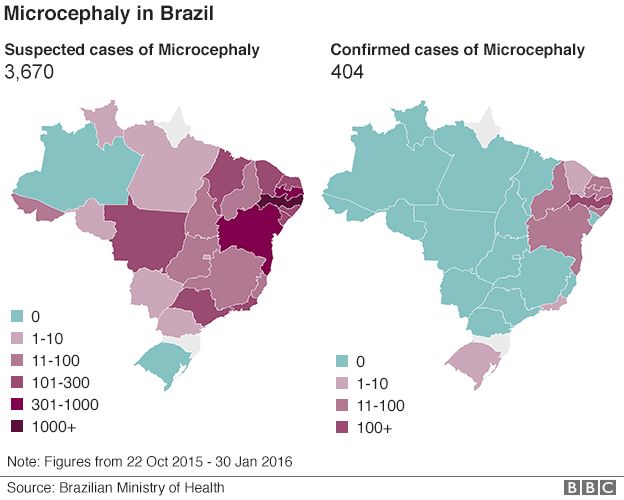
Why hasn’t microcephaly been seen in other countries?
Cases of microcephaly have been centred in north-east Brazil, but the outbreak has affected more than 20 countries.
So where are the other cases of microcephaly?
The outbreak started in Brazil before spreading elsewhere, and the World Health Organization says there will be a lag of several months to know if pregnant women in these newly affected countries are affected too.
There have been suggestions that Zika led to a rise in birth defects after the 2013 outbreak in French Polynesia.
Is it safe to try for a baby?
The link to microcephaly is not certain, but some governments have advised women to delay getting pregnant until more is known.
Women visiting the region have been advised to consider rearranging their trip.
The US Centres for Disease Control says Zika lingers in the blood for about a week.
“The virus will not cause infections in a baby that is conceived after the virus is cleared from the blood,” it says.
“There is currently no evidence that Zika-virus infection poses a risk of birth defects in future pregnancies.”

Why is it a public health emergency?
The World Health Organization is worried that Zika is spreading far and fast, with devastating consequences.
Declaring Zika as a “public health emergency of international concern” singles the disease out as a serious global threat. It puts it in the same category of importance as Ebola.
Unlike Ebola, where the focus was on boots on the ground, with Zika the attention will be on understanding the link with microcephaly.
The WHO will coordinate countries’ health agencies to conduct trials to determine the risk.
It will also encourage efforts to stop the mosquito that spreads the disease as well as finding a treatment or a vaccine to stop the virus.
The work will depend on money donated by countries.
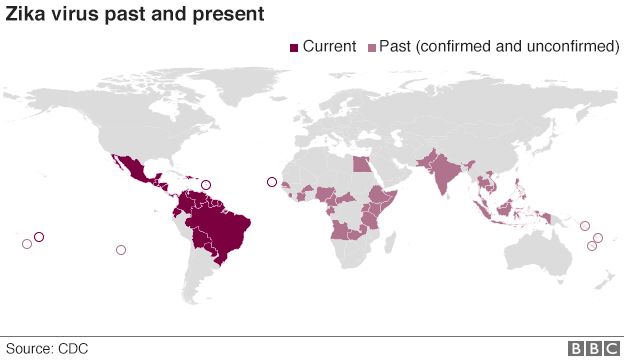

Where did Zika come from?
It was first identified in monkeys in Uganda in 1947.
The first human case was detected in Nigeria in 1954 and there have been further outbreaks in Africa, South East Asia and the Pacific Islands.
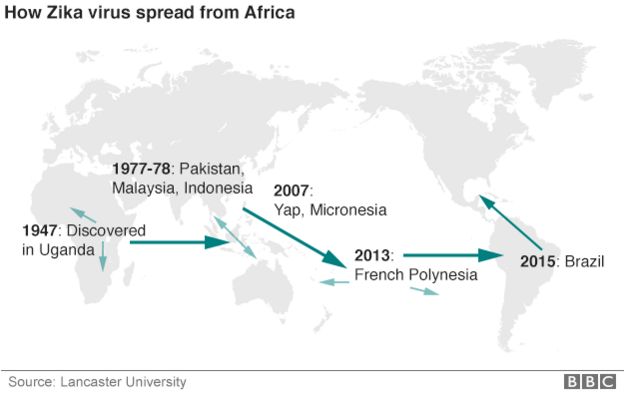
Most were small and Zika has not previously been considered a major threat to human health.
But in May 2015 it was reported in Brazil and has spread rapidly.
It has since also been reported in: Barbados, Bolivia, Colombia, the Dominican Republic, Ecuador, El Salvador, French Guiana, Guatemala, Guadeloupe, Guyana, Haiti, Honduras, Martinique, Mexico, Panama, Paraguay, Puerto Rico, Saint Martin, Suriname and Venezuela.
“Its current explosive pandemic re-emergence is, therefore, truly remarkable,” the US National Institutes of Health said.
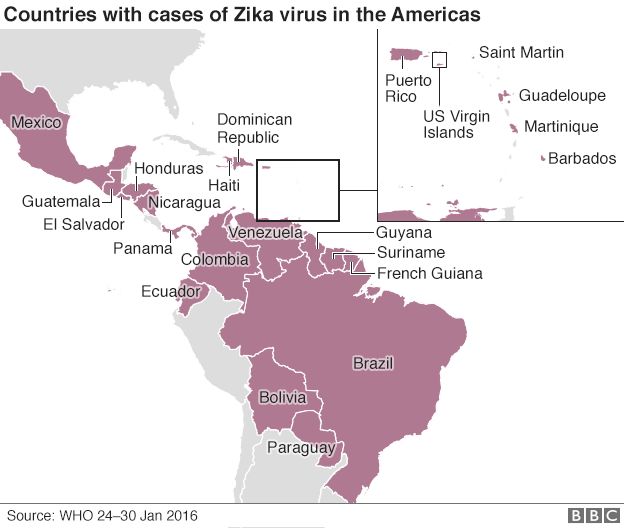

How does it spread?
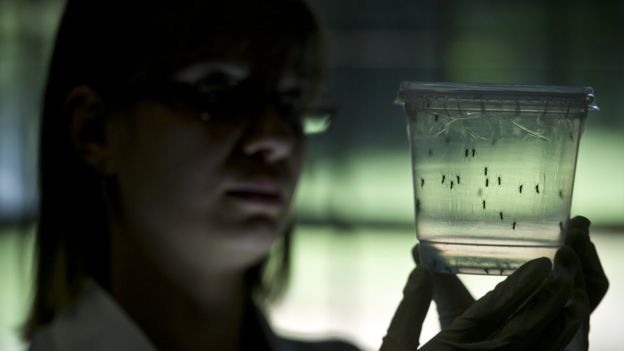
It is spread by Aedes mosquitoes.
They are found throughout the Americas except for Canada and Chile where it is too cold for them to survive.
If they drink the blood of an infected person they can then infect subsequent people they bite.
It is unclear for how long someone can transmit the virus after being infected.
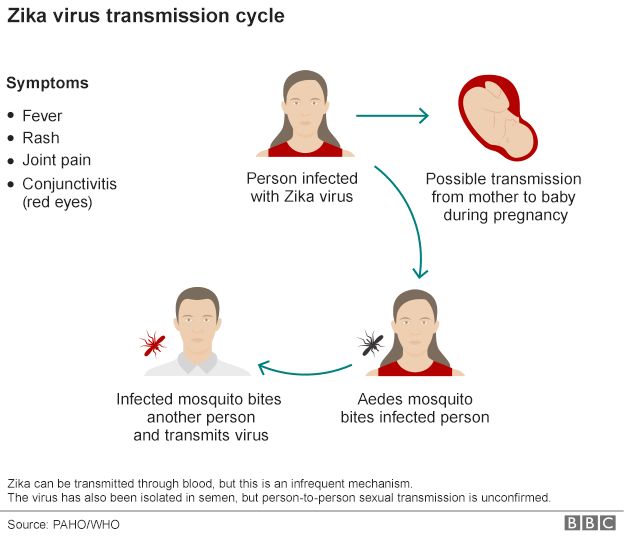
They are the same insects that spread dengue and chikungunya virus.
And, unlike the mosquitoes that spread malaria, they are mostly active during the day, so bed nets offer limited protection.
The WHO expects Zika to spread throughout the Americas, but other scientists have warned that countries in Asia could face large outbreaks too.
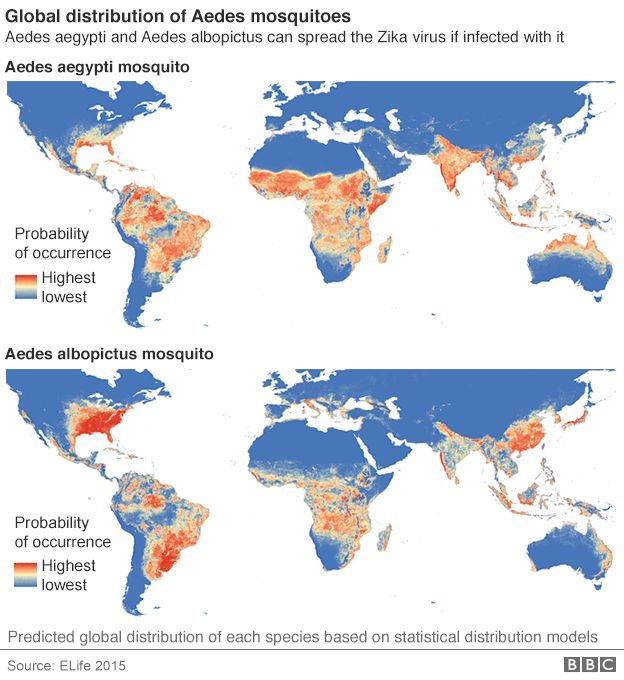

Can it be spread through sex?
There have been reported cases of sexual transmission with the virus spreading to people who have not visited affected countries.
This seems to be a very rare event, but it means Zika has a limited potential to spread in any country – not just those with the Aedes mosquito.
Some countries advise men returning home from affected countries to use condoms if their partner is pregnant or might become pregnant.
This should be done for 28 days after coming home if you have no symptoms, and for six months if Zika symptoms do develop.
Zika virus has also been found in other bodily fluids including saliva and urine, but it is unknown whether the virus can spread through these routes.

How long are people infectious?
The best evidence so far suggests that people can spread the virus via mosquitoes for a week after being infected.
In semen it may persist for two weeks.
Countries have advised safe sex and a ban on blood donations for a month after just visiting such countries and for longer if they developed symptoms.

What can people do?
As there is no treatment, the only option is to reduce the risk of being bitten.
Health officials advise people to:
- use insect repellents
- cover up with long-sleeved clothes
- keep windows and doors closed
The mosquitoes lay their eggs in standing water, so people are also being told to empty buckets and flower pots.
The US Centers for Disease Control has advised pregnant women not to travel to affected areas.

What is being done?
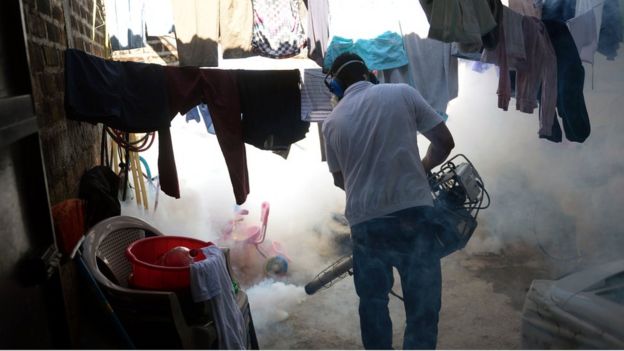
The Brazilian Health Minister, Marcelo Castro, has said a new testing kit is being developed to identify infections quickly.
He also said more money was being put into the development of a vaccine.
Some scientists are also trialling the use of genetically modified sterile mosquitoes that appear to reduce mosquito populations by 90%.
Meanwhile, efforts are under way to kill the mosquitoes with insecticide.
Are the Olympic Games under threat?

Rio de Janeiro is the host city for the 2016 Olympic Games from 5 to 21 August.
The Brazilian authorities will be targeting the mosquitoes’ breeding grounds in the run-up to the Games.
The International Olympic Committee says it is in “close contact” with the Rio organisers and that Olympic venues will be inspected daily in the lead-up to and during this summer’s Games.
It will be to ensure puddles of stagnant water, where mosquitoes breed, are removed to minimise the risk of athletes and visitors coming into contact with the insects.
There is also some hope there will be fewer mosquitoes in August as the month is both cooler and drier.
[Source:- BBC]

